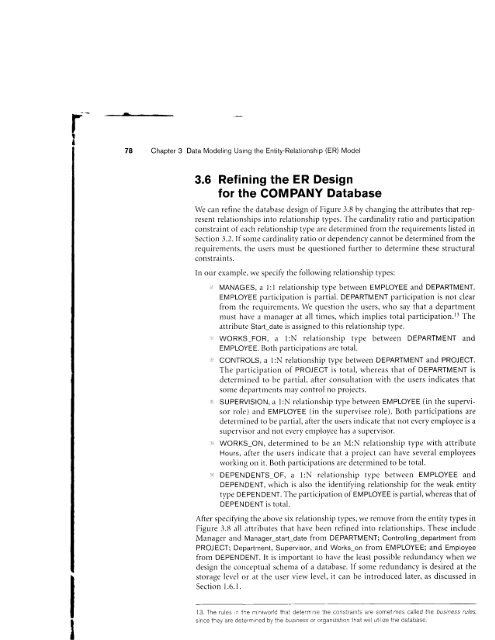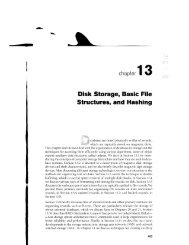this pdf excerpt
this pdf excerpt
this pdf excerpt
Create successful ePaper yourself
Turn your PDF publications into a flip-book with our unique Google optimized e-Paper software.
Chapter 3 Data Modeling Using the Entity-Relationship (ER) Model<br />
3.6 Refining the ER Design<br />
for the COMPANY Database<br />
We ctrn refine the c-latabase design of Figure 3.8 by changing the attributes that represent<br />
relationsl'rips into lelationship types. -fhe cardir-rality ratio and participation<br />
constraint oi each relationship type are determined fiom the reqr-rirements iisted in<br />
Section 3.2. If some cardinality ratio clr dependency cannot be determined from the<br />
requirements, the users must be questior.red further to determine these structural<br />
constraints.<br />
In our example, we specify the following relationship types:<br />
, MANAGES, a l:1 relationship type bc'nveen EMPLOYEE and DEPARTMENT.<br />
EMPLOYEE pirrticipation is partial. DEPARTMENT participation is not clear<br />
from the requirements. We question the users, who say that a department<br />
must have a mauager at all tirnes, which implies total participation.13 The<br />
zrttribr-rte Start_date is assignecl to <strong>this</strong> relationship type.<br />
WORKS-FOR, a l:N relationship type between DEPARTMENT and<br />
EMPLOYEE. Both participations are total.<br />
'i CONTROLS, a l:N relationship type between DEPARTMENT and PROJECT.<br />
The,rrrririrretisn 6f PROJECT is total, whereas that of DEPARTMENT is<br />
deternrined to be partial, after consultation with the users indicates that<br />
some deptrrtments may control no proiects.<br />
i: SUPERVISION, a 1:N relationship type betrveen EMPLOYEE (in the supervisor<br />
role) arrd EMPLOYEE (in the supervisee role). Both participations are<br />
detern.rined to be partial, after the users indicate that r.rot every employee is a<br />
supervisor and not every errrployee has a supervisor.<br />
I WORKS_ON, determined to be an M:N relationship type lvith attribute<br />
Hours, after the users indicate that a project can have several employees<br />
working on it. Both participations are determined to be total.<br />
,': DEPENDENTS_OF, a l:N relationship type between EMPLOYEE and<br />
DEPENDENT, which is also the identifying relationship for the rveak entity<br />
type DEPENDENT. The participation of EMPLOYEE is partial, whereas that of<br />
DEPENDENT is totirl.<br />
Afler specitying the above six rehtionship types, we remove tiorn the entity types in<br />
Figure 3.8 atl attribr-rtes that have been refined into relationships. These include<br />
Manager and Manager-start-date front DEPARTMENT; Controlling-department from<br />
PROJECT; Department, Supervisor, and Works-on from EMPLOYEE; and Employee<br />
from DEPENDENT. It is important to have the least possible redundancywhen we<br />
design the conceptual schema of a database. If some redundancy is desired at the<br />
storage level or at the user view level, it can be introduced later, as discussed in<br />
Section 1.6.1.<br />
13, The rules n the m niworld that determ ne the conslraints are somet mes called the busrness ruies<br />
srnce they are determ ned by the business or organizaton that will utillze the database.














